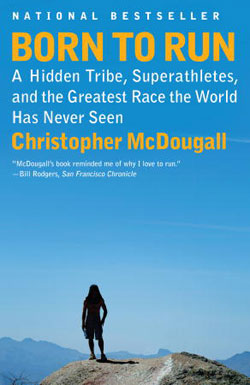For the past few years, I've been a regular '3 mile' runner. Since 2003 I have regularly participated in 2 to 4 local 5k races throughout the year and train in between races by running 3 miles about 3 times a week on average. I'm not a fast runner by any means, my average pace is around 6 min per km (10 mins per mile) and I was not a long distance runner. I ran my first 10k race time in 2004. I tried again in 2005 and even though I was able to finish, I had a pulled muscle injury that took me several weeks to recover. I attributed my injury to being overweight. At 200lb I am more than 30% above my ideal weight. After that injury, I decided to stick to 5k runs until I could lose some weight. In 2010 I had only managed to lose a few pounds, but I decided to try running 10k again and I was able to finish without any injuries again.
 Then in 2011 I had a major breakthrough. Early in January I read Born to run by Chris McDougall. Even before midway through the book my running improved significantly. I discovered that even though my weight was a limiting factor, my running form had an even bigger limiting impact.
Then in 2011 I had a major breakthrough. Early in January I read Born to run by Chris McDougall. Even before midway through the book my running improved significantly. I discovered that even though my weight was a limiting factor, my running form had an even bigger limiting impact.Before reading this book, I had never paid attention to my running form. I did not even know I was a heel striker. When I was in high school I was on the track and field team and I was taught techniques to run fast, essentially how to do 'power running', but I was never taught techniques to run long distances. After reading 'Born to run', I tried changing my stride to a forefoot strike and slightly bending my knees while running. I was surprised at the results. I was not only able to run longer distances, but also able to run frequently without feeling injured.
I also learned that the high heel on typical running shoes was encouraging me to land more on my heel which was likely the source of most of my injuries. I found a pair of Nike Free 3.0 on sale and gave them a try and absolutely loved them.
Unfortunately Nike hasn't learned their lesson and the latest Nike Free Run+ 2 shoes have a really thick heel. I also tried the Vibram FiveFingers Bikila. Those require more time getting used to. At first, I did not think I would be able to run over 5k, now I can comfortably run distances under 10k and I loved them. I feel it strengthen my foot muscles, but I still prefer the Nike Free for longer distances so I keep alternating between them.
Within 4 months after starting reading the book my improvement was remarkable, I had ran a cumulative of over 500km and my longest distance went from 10km to close to 20km. I was ready to run my first half marathon which I did on May 15, 2011 in Pittsburgh.
I didn't expect to be able to maintain my average pace throughout the run, but I did and I probably pushed myself a bit hard since I did have a injury on my right foot which took a couple weeks to recover from. But despite this I really enjoyed the experience and by the end of 2011 I had ran 1,670km which is twice as much what I ran on 2010. I am currently registered and training to run my first marathon in 2012. Happy running everyone!














